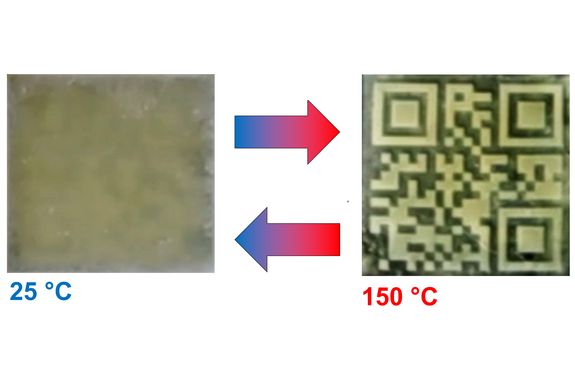3D printing is extremely practical when you want to produce small quantities of customised components. However, this technology has always had one major problem: 3D printers can only process a single material at a time. Until now, objects with different material properties in different areas could only be 3D printed at great expense, if at all.
Researchers at TU Wien have now developed methods for giving a 3D-printed object not only the desired shape, but also the desired material properties, point by point. The versatility of this technology has been demonstrated in several applications: for example, it is possible to print an invisible QR code that only becomes visible at certain temperatures. The results have now been published in the renowned journal “Nature Communications”.
Different material properties point by point
Katharina Ehrmann's research team at the Institute of Applied Synthetic Chemistry at TU Wien works with liquid materials that are irradiated with light. A chemical reaction is triggered exactly where the light hits the liquid. The molecular building blocks in the liquid bond with each other and the material becomes solid.
What is new is that it is now possible to precisely control how the liquid hardens and what properties the resulting material has. “We can use different light intensities, different wavelengths, or different temperatures,” says Katharina Ehrmann. “All of this can be used to influence the properties of the 3D-printed material.”
In this way, it is possible to control how the molecular building blocks in the liquid bond with each other when they become a solid object. They can arrange themselves regularly, like spaghetti in a packet, and form a crystal, or they can lie amorphously and disorderly, like cooked spaghetti on a plate.
“Depending on the crystallinity, the material properties can also vary greatly,“ explains Michael Göschl. "Crystalline materials tend to be hard and brittle, while amorphous materials can often be soft and elastic. The optical properties can also vary, from glass-like transparency to opaque white," says Dominik Laa. Michael Göschl and Dominik Laa are the first authors of the current publication, both of whom are researchers in Katharina Ehrmann and Jürgen Stampfl's teams.
The invisible QR code
The team has now demonstrated the versatility of the new method in several examples. For example, a QR code was created inside a piece of plastic, which is covered by a crystalline layer. However, this layer loses its crystallinity at a certain temperature and becomes transparent – the secret QR code suddenly becomes visible. Depending on the material and temperature, it is also possible to destroy the QR code temporarily, similar to a temporary access denial on your phone if you enter the wrong code.
In the same way, it was also possible to print a warning symbol that only becomes visible when the material is heated above a certain temperature. This can be used, for example, to check whether the prescribed temperature range is being exceeded during the transport of heat-sensitive goods.
The optical characterisation of the material was also carried out at TU Wien – in Prof. Andrei Pimenov's research group at the Institute of Solid State Physics.
“We are offering a completely new range of possibilities for 3D printing,” says Katharina Ehrmann. “Potential applications can be envisaged in many different areas, from data storage and security to biomedical applications.”


